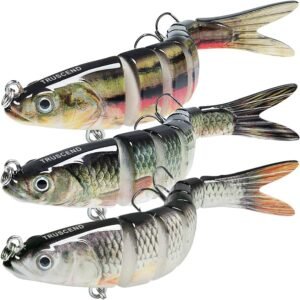The Best Bass Fishing Lures for Outstanding Catches
Bass fishing requires not only skill and patience but also the right tools. Among the most crucial tools in any angler’s arsenal are fishing lures. Let’s determine the best bass fishing lures you must have in your collection!

Bass fishing lures encompass a wide range of artificial baits that entice bass into biting. These lures come in various shapes, sizes, colors, and materials, each designed to imitate specific types of prey that bass commonly feed on in their natural habitats. The effectiveness of a lure lies in its ability to trigger a bass’s predatory instincts, enticing them to strike.
Choosing the Best Fishing Lures
Selecting the right lures is paramount for successful bass fishing adventures. Bass are known for their selective feeding behavior and can sometimes be demanding. Using the wrong lure can result in countless hours spent on the water without significant bites.
Each type of lure has its unique action and movement that triggers different instinctual responses from bass depending on their feeding patterns and preferences. By understanding the different types of lures available and their specific applications, anglers can increase their chances of attracting bites from even the most elusive bass specimens.
The right choice in lure selection allows anglers to adapt to varying water conditions, weather patterns, and seasonal changes while effectively imitating natural prey movements. The key lies in selecting the appropriate lure and presenting it correctly through techniques such as casting accuracy, retrieval speed variations, and manipulation of the lure’s movement.
The ability to mimic natural prey convincingly can make all the difference in enticing a bass to strike and ultimately achieving a successful fishing outing. Now, let’s delve into the world of bass fishing lures, exploring various categories and subcategories that offer an array of choices for anglers seeking success on the water.
Topwater Lures
Popper lures are used for creating surface commotion and attracting bait. In topwater fishing, popper lures are a staple in every bass angler’s tackle box. These uniquely designed lures feature a concave face thousand when jerked or twitched on the water’s surface. The loud noise and water disturbance simulate the commotion caused by injured prey, grabbing the attention of nearby bass.
Popper lures excel in calm conditions or during low light periods when bass rely heavily on their sense of hearing and vibration detection. Whether you choose a classic cork popper or a modern plastic version, using quick and deliberate jerks to make the lure splash and create ripples will trigger aggressive strikes from hungry bass.
Buzzbaits that imitate injured prey on the water’s surface
Buzzbaits are another fantastic option for enticing explosive topwater strikes from bass. These unique lures consist of a wire frame with one or two spinning blades at the front, resembling an injured baitfish struggling on the water’s surface. As you retrieve the buzz bait, its blades create a buzzing sound that mimics distressed prey, attracting nearby curious bass.
The key to effectively fishing buzz baits is maintaining a steady retrieve speed while occasionally pausing or speeding up to imitate erratic movements. Experimenting with different blade colors (silver, gold) and skirt designs can help find what triggers aggressive bites in specific conditions or locations.
Walking baits for a side-to-side action that mimics a wounded baitfish
Walking baits, such as stick baits or pencil poppers, are designed to replicate the darting action of an injured baitfish gliding across the water’s surface. These long and slender lures have flat sides that allow them to walk effortlessly when twitched with the rod tip. By imparting a rhythmic left-to-right motion, you can mimic the erratic movements of wounded prey, eliciting predatory instincts in the bass.
Walking baits are particularly effective in calm water conditions or when bass are feeding on top, as their subtle but enticing action can entice even the most finicky fish. Opt for natural colors that resemble local baitfish and experiment with different retrieve speeds and cadences to find what triggers the most strikes.
Crankbaits
Shallow-diving crankbaits for targeting bass in shallow waters near cover
When bass are holding near shallow cover like submerged vegetation or fallen trees, shallow-diving crankbaits come into play. These lures have a compact body shape with a wide lip that allows them to dive quickly and maintain depth between 1 to 6 feet. The key is to choose a crankbait that matches the depth of your targeted fishing area while also considering the type of structure present.
Shallow-diving crankbaits excel at deflecting off the cover, triggering reaction strikes from hiding bass. Their tight wobble and quick diving action make them irresistible to aggressive fish in shallower areas.
Medium-diving crankbaits to explore mid-depth areas where bass often feed
Medium-diving crankbaits provide excellent coverage and versatility for targeting mid-depth areas where bass typically feed or hold during different seasons. With their longer lip design, these lures can dive between 6 and 12 feet deep and effectively explore structures such as rock piles or submerged points.
The key is to match the diving depth of your crankbait with the target zone where you believe active fish may be present. Medium-divers often have a wider wobble than shallow-divers, providing greater disturbance and attracting attention from nearby bass.
Deep-diving crankbaits are designed to reach greater depths and target deeper structures.
Deep-diving crankbaits are indispensable when targeting bass in deeper waters or along steep drop-offs. These lures have elongated lips that allow them to dive up to 20 feet or more, precisely reaching the depths where bass often hold. Deep divers excel at exploring offshore structures like submerged humps, points, or ledges.
Their tight wobble and ability to maintain depth while retrieving make them efficient at covering vast areas and triggering strikes from bottom-oriented bass. Choosing the appropriate line strength and using a slow and steady retrieve when employing these lures is crucial to maximizing their effectiveness at greater depths.
Soft Plastic Baits
Worms, both straight-tail and curly-tail, are versatile and effective in various conditions. on
Worms are perhaps the most versatile soft plastic baits for bass fishing. Available in countless colors and sizes, such as straight-tail or curly-tail variations, they can be fished in multiple ways based on water conditions and fish behavior. Straight-tail worms work exceptionally well when rigged Texas-style with a bullet weight for flipping into heavy cover or Carolina-rigged for covering expansive areas.
Curly-tail worms shine when rigged on a shaky head jig for finesse presentations or on a drop shot rig for enticing suspended fish. The lifelike action of these worm ba, combined with their ability to imitate various prey ty, makes them go-to options year-round.
Creature baits mimic crawfish or other aquatic creatures, enticing predatory instinct.CTS
Creature baits are designed to replicate aquatic creatures like crawfish or other bottom-dwelling prey that bass find irresistible. These soft plastic lures feature multiple appendages, realistic textures, and sometimes built-in rattles to provoke a response from nearby bass.
By flipping or pitching creature baits into the cover or dragging them along the bottom, you can effectively imitate the natural movement of these creatures, triggering predatory instincts in the bass. Experimenting with different colors and sizes will help determine what entices bass in specific environments.
Swimbaits imitate injured fish with their lifelike swimming act.ion
Swimbaits have gained immense popularity among bass anglers due to their incredible lifelike swimming activity, which perfectly mimics an injured baitfish. These soft plastic lures come in various shapes, sizes, and colors, ranging from small paddle tails to larger joint models. The realistic swimming motion of swimbaits entices bass by tapping into their instinct to target vulnerable prey.
They excel in open water situations such as fishing around submerged points or ledges or schooling fish. Slow and steady retrieves are often preferred to allow the swimbait’s action to shine through and fool even the most wary predators lurking below.
More Bass Fishing Lures
Jigging Techniques and Lure Selection
Jig fishing is a versatile and effective technique for targeting bass in various conditions. Understanding different jig styles can greatly enhance your success on the water. Football jigs, with their wide, flat heads, are perfect for dragging along rocky bottoms and mimicking crawfish.
On the other hand, flipping jigs excel in heavy such as submerged vegetation or brush piles, allowing you to penetrate those hard-to-reach areas where big bass lurk. Finesse jigs are ideal for clear water or when the fish are finicky; their compact size and subtle action entice even the most wary of bass.
When selecting the right jig weight, consider the water depth and current conditions—a heavier jig may be necessary for deeper waters or strong currents to maintain proper control and contact with the bottom. To attract bites, employ techniques like pitching (accurate casting to specific targets), flipping (dropping the lure vertically into cover), dragging (slowly crawling it across the bottom), or hopping (giving it short upward jerks) to imitate natural prey movements that trigger predatory instincts.
Spinnerbait Selection
Spinnerbaits have long been hailed as go-to lures for enticing strikes from hungry bass. Understanding blade types is crucial in maximizing lure action and attracting attention underwater.
The Colorado blade features a rounded shape that generates strong vibrations and slow rotation—ideal for murky waters or when you want a slower presentation to allow bass more time to detect and strike at your bait. On the other hand, Willowleaf blades have a sleeker profile with more pronounced spin at higher speeds—perfect for clear water conditions or when you need to cover large areas quickly while providing adequate flash to catch nearby bass’ attention.
Experimenting with different blade sizes can also make a difference, as larger blades create more water disturbance and draw attention from the bass at greater distances. Remember, spinnerbaits are excellent for efficiently covering water, so cast them near the structure, retrieve them at varied speeds, and occasionally pause to trigger reaction strikes from lurking bass.
Conclusion
As we delve into the niche subtopics of jigging techniques and spinner bait selection in the realm of bass fishing lures, it becomes evident that there is no shortage of strategies and choices available to anglers. You can effectively imitate natural prey movements that entice even the wary bass by exploring the various jig styles and selecting the appropriate weight based on water depth and conditions. Similarly, understanding blade types in spinnerbait selection allows you to adjust your presentation according to water clarity and desired lure action.
With these insights and some experimentation on the water, you’ll be well-equipped to elevate your bass fishing game. So go for confidence, armed with knowledge, passion, and an unwavering determination to catch that trophy-sized bass!






